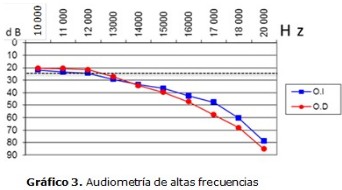Audiometría de altas frecuencias: utilidad en el diagnóstico audiológico de la hipoacusia inducida por ruidos
Resumen
Fundamento: la disponibilidad de reproductores de audio ha aumentado y potenciado la exposición a ruidos intensos por periodos prolongados. Este ruido recreacional resultado de las actividades de esparcimiento, como el uso de reproductores de música, asistencia a conciertos, discotecas, es un factor de riesgo para presentar deterioro auditivo; donde la hipoacusia inducida por el ruido es una de las principales causas de discapacidad prevenible.
Objetivo: determinar la utilidad de la audiometría de altas frecuencias, para la predicción de hipoacusias inducidas por ruidos.
Métodos: se realizó un estudio observacional, analítico, transversal, con encuesta, examen físico de Otorrinolaringología, audiometría tonal liminar y audiometría de altas frecuencias desde septiembre de 2013 hasta junio 2016 a 80 adolescentes de la provincia La Habana para describir la incidencia de las hipoacusias inducidas por ruido y su relación con los factores que las producen.
Resultados: la audiometría tonal realizada a los 80 adolescentes fue normal y la audiometría de altas frecuencias comenzó a disminuir la audición a partir de 13 000 Hz donde se observó una hipoacusia neurosensorial en aumento hasta 90 dB en 20 000 Hz de frecuencia. Todos los adolescentes estudiados usan reproductores de música personal más de dos horas diarias.
Conclusiones: considerar la audiometría de alta frecuencia como un método diagnóstico para la detección temprana de trastornos de audición en pacientes con riesgo específico como la exposición a ruidos, con el fin de que se convierta en una herramienta habitual en la exploración audiológica.
DeCS: AUDIOMETRÍA; PÉRDIDA AUDITIVA PROVOCADA POR RUIDO; PÉRDIDA AUDITIVA DE ALTA FRECUENCIA; ADOLESCENTE; ESTUDIO OBSERVACIONAL.
Descargas
Citas
1.Rodríguez Valiente A, Roldan Fidalgo A, García Berrocal JR, Ramírez Camacho R. Hearing threshold levels for an otologically screened population in Spain. Int J Audiol. 2015 Agu;54(8):499-506.
2.Rodríguez Valiente A, Trinidad A, García Berrocal JR, Górriz C, Ramírez Camacho R. Extended high-frequency (9-20 kHz) audiometry reference thresholds in 645 healthy subjects. Int J Audiol. 2014 Agu;53(8):531-45.
3.Rodríguez Valiente A, García Berrocal JR, Roldán Fidalgo A, Trinidad A, Ramírez Camacho R. Earphones in extended high-frequency audiometry and ISO 389-5. Int J Audiol. 2014 Sep;53(9):595-603.
4.Hernández Sánchez H. Reproductores de música personal y su influencia sobre la salud auditiva. Rev Cubana Otorrinolaringol Cirug Cabeza y Cuello [Internet]. 2013 [citado 12 Abr 2017];1(2):[aprox. 7 p.]. Disponible en: http://www.revotorrino.sld.cu/index.php/otl/article/view/21/105
5.International Organization for Standardization. Acoustics. Audiometric test methods-Part 1: Pure-tone air and bone conduction audiometry. ISO 8253-1: 2010. Geneva: ISO; 2010.
6.García Ortiz MJ, Torres Núñez MM, Torres Fortuny A, Alfonso Muñoz E, Cruz Sánchez F. Hipoacusia induzida por ruído através da audiometria de altas frequências. Adolesc Saude. Jan-Mar 2016;13(1):57-65.
7.Figueroa Hernández D, González Sánchez D. Relación entre la pérdida de la audición y la exposición al ruido recreativo. An ORL Mex [Internet]. 2011 [citado 20 Ene 2016];56(1):[aprox. 7 p.]. Disponible en:http://www.medigraphic.com/pdfs/anaotomex/aom-2011/aom111c.pdf
8.Jefferson CGA, Kamps M. Hipoacusia de origen laboral. Rev Méd Costa Rica Centroamérica [Internet]. 2011 [citado 12 Abr 2017];68:[aprox. 9 p.]. Disponible en: http://www.binasss.sa.cr/revistas/rmcc/599/art11.pdf
9.Maya González E, Velásquez Ortiz A. Manifestaciones clínicas secundarias a la exposición por ruido recreacional en los alumnos de la licenciatura de gastronomía de la UAE-Mex [tesis]. México: Universidad Autónoma del Estado de México; 2014.
10.Espinoza Guamán PS, Serpa Andrade DF, Toral Guido R. Hipoacusia inducida por ruido recreativo. Rev Mex Panorama Médico. 2014;8(1):70-5.
11.Levey S, Levey T, Fligor B. Noise Exposure Estimates of Urban MP3 Player Users. J Speech Lang Hear Res. 2011;54:263-77.
12.Mah.org.ar [Internet]. Argentina:Mutualidad Argentina de Hipoacúsicos (MAH); c1952-2017 [citado 12 Abr 2017]. Grados y Tipos de hipoacusia; [aprox. 1 pantalla]. Disponible en: http://www.mah.org.ar/grados-de-hipoacusia
13.Barrett KE, Barman SM, Boitano S, Brooks HL. Ganong:Fisiología Médica. 23 ed. México: McGraw-Hill; 2010.
14. García Ortiz MJ. Cuidados de la audición. En: Cruz Sánchez F, Rodríguez Alonso B, Alonso Uría RM, editores. La puericultura en la adolescencia. Habana Cuba: MINSAP y Unicef; 2014. p. 109-113.
15.Hernández Sánchez H. Hipoacusia inducida por ruido: estado actual. Rev Cubana Otorrinolaringol Cirug Cabeza y Cuello. 2013;1(2):46-58.
16.Henry P, Foots A. Comparison of user volume control settings for portable music players with three earphone configurations in quiet and noisy environments. J Am Acad Audiol. 2012 Mar;23(3):182-91.
17.Rodríguez Valiente A, Pérez Sanz C, Górriz A, Juárez M, Monfort J, García Berrocal R. Diseño de una nueva herramienta para la exploración auditiva. Acta Otorrinolaringol Esp. 2009;60:43-8.

Publicado
Cómo citar
Número
Sección
Licencia
La Revista Archivo Medico Camagüey, ofrece de forma inmediata después de ser indexada en el Proyecto SciELO; acceso abierto al texto completo de los artículos bajo el principio de hacer disponible y gratuita la investigación para favorecer el intercambio del conocimiento global y coadyuvar a una mayor extensión, publicación, evaluación y uso extensivo de los artículos que se exponen pudiendo ser utilizados, sin fines comerciales, siempre y cuando se haga referencia a la fuente primaria.
Carta De Declaración De Autoría u Derechos De Autor(a)
Conflictos de intereses: los autores deberán declarar de forma obligatoria la presencia o no de conflictos de intereses en relación con la investigación presentada. (Descargar Plantilla para declarar confictos de intereses)
La Revista Archivo Médico Camagüey se encuentra bajo una
Licencia Creative Commons Reconocimiento-NoComercial 4.0 International (CC BY NC 4.0).
Esta licencia permite a otros distribuir, mezclar, ajustar y construir a partir de su obra, incluso con fines comerciales, siempre que le sea reconocida la autoría de la creación original. Esta es la licencia más servicial de las ofrecidas. Recomendada para una máxima difusión y utilización de los materiales sujetos a la licencia. La licencia completa puede consultarse en: https://creativecommons.org/licenses/












